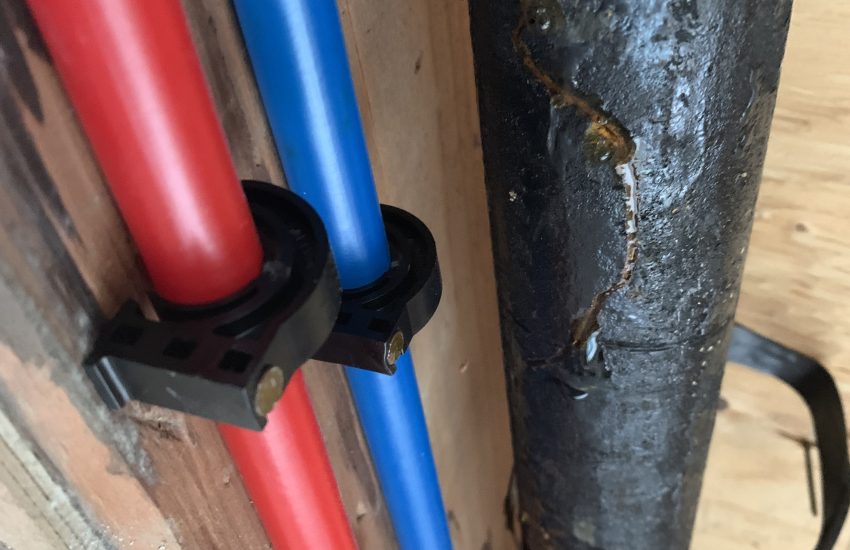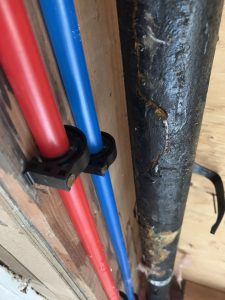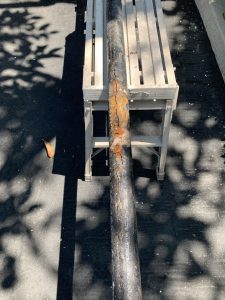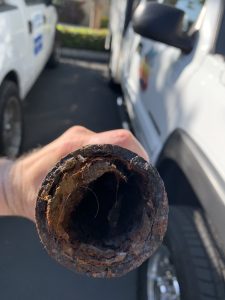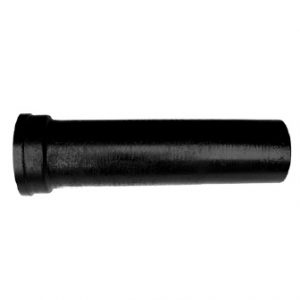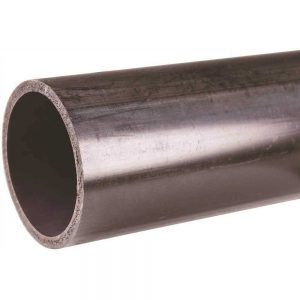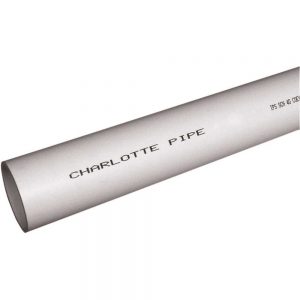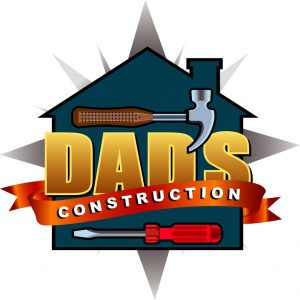Pipe Leak
Almost everyone in Orange County knows about copper pipe leaks. Either you have experienced a pipe leak or know of someone who has. When folks experience a pipe leak, they typically have their house re-piped. After this expensive and inconvenient undertaking and all the holes are patched, everything is good – right? Maybe not.
Where else can a pipe leak in my house?
Orange County like other parts of the country used cast iron pipe extensively up to the early 1980’s for residential home sewer and drainage systems. Cast iron was used in the ceilings, walls, and below ground. Due to the cost of cast iron sewer and drainpipes, most residential home builders began using ABS and PVC sewer and drainpipe underground and in areas where sound was not important. Sound? Yes – there is nothing better than cast iron to eliminate the sound of water running through your ceilings and walls. It is VERY QUIET! Therefore, when the shower is on, or the toilet is flushed over the family room or kitchen you cannot hear running water. But there is a dark side.
I can get a pipe leak from cast iron pipes?
When cast iron pipes carry waste, hydrogen sulfide gasses are created. When these gasses oxidize, corrosive sulfuric acid is created. This causes cast iron pipes to rust from the inside out. Combined with the water flowing through the pipe, cast iron pipes can easily start leaking in 30 years or less. Household cleaning products with acidic properties accelerate the process. Take a look at these short videos of a Cast Iron Pipe Leak in Ceiling and Cast Iron Pipe Leak in Wall. This is exactly what many Orange County residents are now starting to experience. Both of these occurred in the last 10 days. One was in Rancho Santa Margareta while the other was in Mission Viejo. Notice the large cracks in these cast iron pipes.
|
|
|
The pipe illustrated immediately above is a 2-inch shower drain. But wait – that is not a sewer pipe. Yes, it is. Any pipe that carry’s human secretions is a sewer pipe. Although shower water is considered gray water, it carry’s human secretion residue such as urine, fecal, dead skin cells, hair, menstrual fluids, etc. For those who enjoy urinating in the shower, your shower drain immediately becomes a sewer pipe. If your shower drain connects to a toilet drain (very common and legal), those harmful hydrogen sulfide gasses coming from the toilet move into the shower and sink drains.
So, after I install new PEX water pipes, I can still get a pipe leak in my ceiling and walls?
Yes! If you have cast iron sanitary (sewer) and/or drainpipes in your ceilings and walls, replace these with ABS or PVC when you re-pipe your house. If your home was built prior to 2010, a smarter and less expensive option is to perform the PEX and cast iron re-pipe before the leaks happen. Why? Do you really want to go through the expense, mess, and inconvenience of opening your ceilings and walls again to replace the cast iron sewer pipes?
Notice in the above picture you can see new PEX water lines below the cast iron pipe. After only 22 years, the house was experiencing leaks from the original copper water pipes. After a few of these, the client did the smart thing and re-piped the house using PEX. However, only 8 years later, pipe leaks developed from the cast iron pipe. Why were the cast iron pipes not replaced during the PEX re-pipe? The industry did not know about the looming cast iron pipe crisis. In the same manner as copper water pipes, nobody knew or could have anticipated the pipe leak issues with cast iron pipes.
Remember, the idea behind cast iron was to almost eliminate the sound of running water completely. With a 100-year life expectancy, cast iron checked all the boxes. It was not a cost issue. Cast iron costs more to install than ABS or PVC plastic pipe. Builders were not trying to cut costs. They were trying to eliminate the sound of the shower running and toilet flushing while watching TV downstairs!
When I replace cast iron pipe, what should I use?
Always replace the cast iron pipe when you re-pipe your home so you eliminate another pipe leak opportunity. Using ABS versus PVC when replacing cast iron pipe is a toss-up. Personally, I like to use solid core schedule 40 ABS pipe. When replacing, I insulate heavily around the pipe.
What is the difference between ABS and PVC?
PVC vs. ABS. Both Acrylonitrile Butadiene Styrene (ABS) and Poly Vinyl Chloride (PVC) come in schedule 40 and 80 thickness. ABS is black while PVC is white. ABS and PVC are available in Drain-Waste-Vent (DWV) foam and solid core. Foam core pipe is lighter, less rigid (not as strong), and cheaper. Neither ABS or PVC foam core pipe is rated for pressurized uses. However, both plastics are resistant to chemical and water degradation. In regards to price, ABS and PVC are similar in cost.
|
|
|
Solid core PVC pipe is rated for up to 220 psi. It is more flexible and thought to be better at muffling the sound of running water. PVC has a 140°F maximum working temperature. Schedule 40 PVC is highly durable, with high tensile and impact strength. It is easy to install and has better sound deadening qualities than PVC Schedule 40 Foam Core and ABS Foam Core pipe. PVC is less durable than ABS. Why? It’s designed to be flexible and softer than other plastics. Schedule 40 PVC DWV systems are suitable for fire-rated wall, floor, and ceiling assemblies. PVC generally comes with a 5-year warranty.
Solid core ABS is rated for about 217 psi. It is significantly stronger and more shock and impact resistant than PVC. Solid Core Schedule 40 ABS is renowned for its exceptional high impact strength, durability, and toughness. It has a 180°F maximum working temperature. Schedule 40 ABS DWV systems are suitable for fire-rated wall, floor, and ceiling assemblies. ABS is better at handling severely cold temperatures and generally comes with a 1-year warranty.
How Can I Receive More Information?
If you would like more information on enjoying the best re-pipe, bathroom, kitchen, and interior remodeling experience in Orange County, call Dan at (949) 380-0177 or at dan@dadsconstruction.com for a free in home consultation. DAD’s serves all of South Orange County California. This includes Lake Forest, Mission Viejo, Foothill Ranch, Portola Hills, Ladera Ranch, Irvine, San Clemente, Dana Point, San Juan Capistrano, Rancho Santa Margarita, Coto de Caza, Dove Canyon, Laguna Niguel, Laguna Hills, Laguna Beach, Newport Beach, and Aliso Viejo..
“Taking Care of Your Home . . . The Way We Would Our Own”
Daniel A. Derkum is the owner of DAD’s Construction. DAD’s is a leading South Orange County, California design-and-build remodeling and renovation Contractor. See https://www.dadsconstruction.com. © DAD’s Home Services & Construction, Inc. All Rights Reserved.
